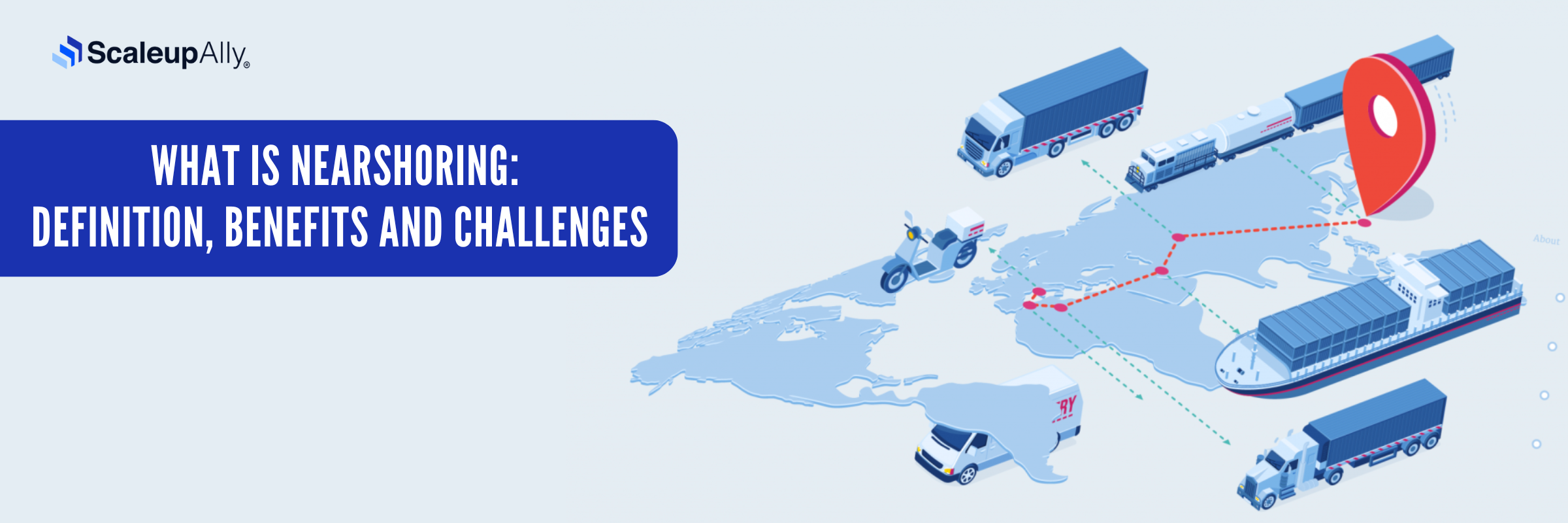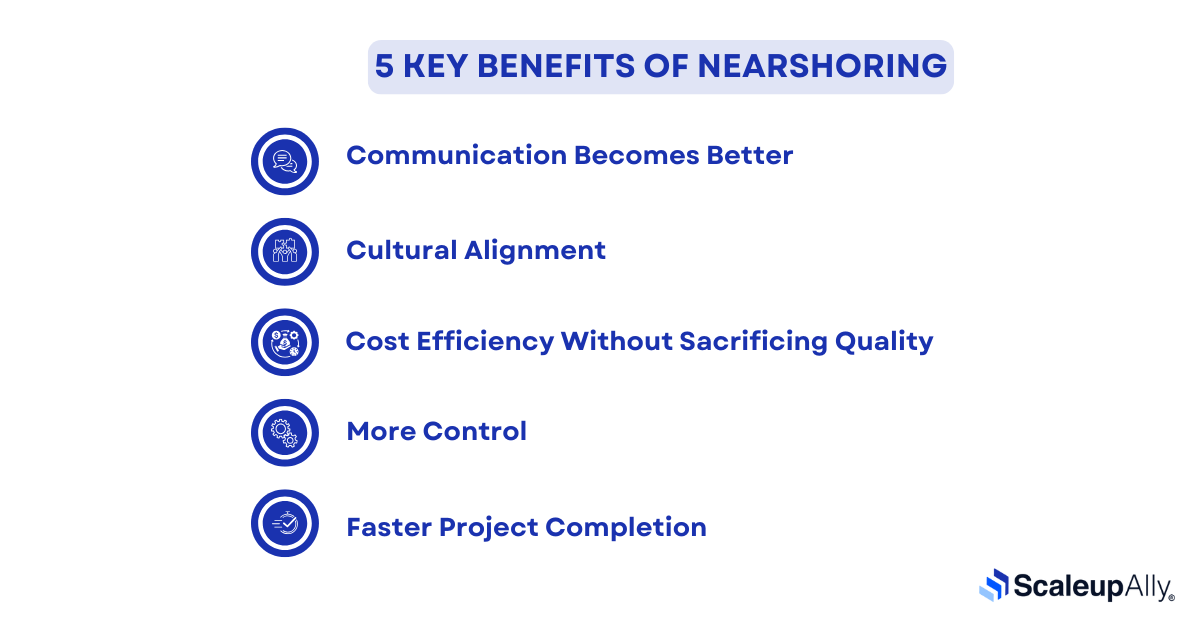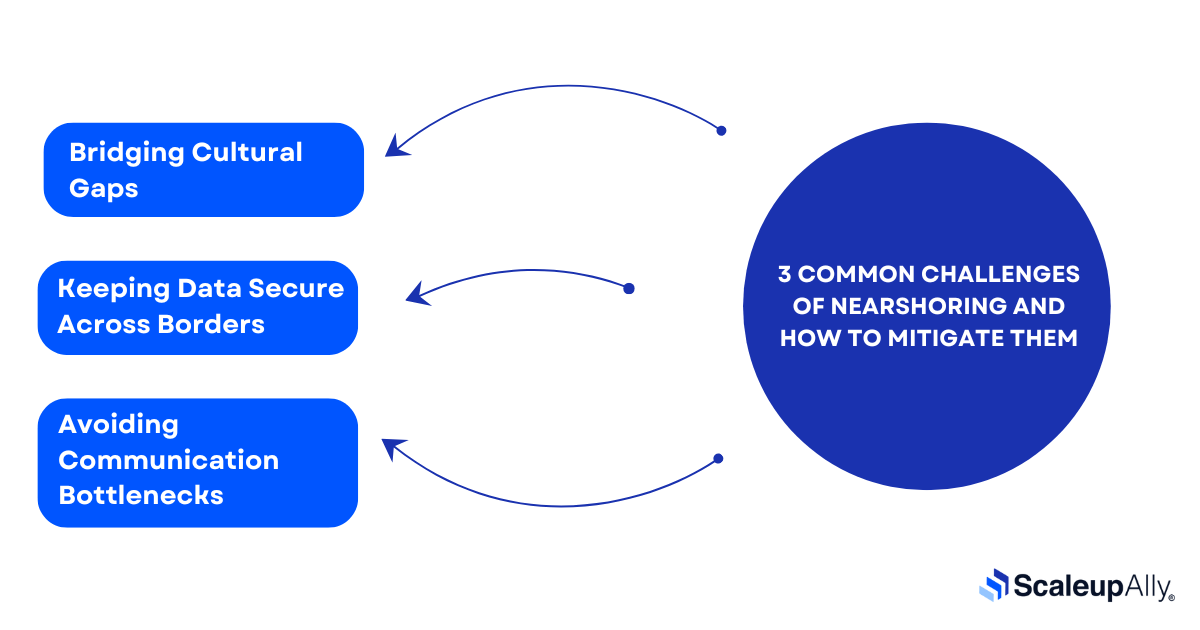
What is Nearshoring: Definition, Benefits and Challenges
Pranay Agrawal | November 28, 2024 , 13 min read
Table Of Content
The business you started small, is now thriving and expanding. This results in an increase in the workload, and you are in need of help! However, it is easier said than done.
Even outsourcing halfway across the world feels like a gamble. Your only solution to this is nearshoring, where you can build partnerships with teams close by and balance cost-effectiveness with real-time collaboration. Nearshoring keeps your support team close enough to understand your needs yet far enough to make financial sense. So, is this strategy the answer to your growth’s sweet pains?
In this blog, we will break down the nearshoring definition, the benefits it offers, and the challenges that might surprise you.
Key Takeaways
- Nearshoring brings skilled teams closer and makes communication and collaboration much smoother.
- Cultural alignment and overlapping work hours make nearshoring more connected by bridging gaps that traditional offshoring often faces.
- A successful nearshore partnership is about building trust, clear communication, and a shared commitment to project goals.
- Nearshoring offers an adaptable, cost-effective pathway for businesses ready to scale efficiently while staying close to their operational values.
What is Nearshoring?
- What is Nearshoring?
- 5 Key Benefits of Nearshoring
- Nearshoring vs. Offshoring vs. Onshoring: A Comparative Analysis
- Steps to Implement Nearshoring in Your Business
- 3 Common Challenges of Nearshoring and How to Mitigate Them
- Industries that Benefit Most from Nearshoring
- How ScaleupAlly Can Help?
- Conclusion
- Frequently Asked Questions
Nearshoring is the practice of outsourcing tasks or services to companies or teams in nearby countries rather than far-flung ones to keep operations “closer to home”. This lets companies benefit from geographical proximity, similar time zones, and often a closer cultural understanding.
Unlike traditional offshoring, where teams might be half a world away, nearshoring partners are at just a short flight or a few hours’ difference.
5 Key Benefits of Nearshoring

Here are five standout advantages of nearshoring that make it an appealing choice for growing companies.
1. Communication Becomes Better
When your team works in a similar or overlapping time zone, conversations are faster, and so updates are timely. These lead to less frequent misunderstandings. With nearshoring, you’re not chasing updates overnight or dealing with prolonged response times, so projects move forward smoothly.
2. Cultural Alignment
Nearshoring often means working with teams who share closer cultural values and business practices. This arrangement makes collaboration feel more natural. The cultural closeness reduces friction in communication and helps everyone stay on the same page when creative problem-solving is involved.
3. Cost Efficiency Without Sacrificing Quality
Nearshoring typically provides skilled talent at a lower cost than local hires but with more affordable travel and fewer logistical issues than distant offshoring because you get skilled professionals who are accessible without breaking the bank, and offer a balance to budget and expertise.
4. More Control
Proximity makes it easier to visit and manage your nearshore team if needed for project oversight or training. Nearshoring gives you the option to maintain hands-on involvement while still reaping the benefits of an outsourced partnership.
5. Faster Project Completion
Nearshoring can accelerate development cycles with quicker communication and more manageable travel. Real-time collaboration means tackling challenges and making adjustments whenever required. This often results in faster project completion and an agile way to meet market demands.
Nearshoring vs. Offshoring vs. Onshoring: A Comparative Analysis
When companies want to outsource, they weigh the differences between nearshoring, offshoring, and onshoring to find what’s best for their needs. Each of these outsourcing models comes with distinct advantages and challenges.
Below is a comparison of these three strategies across key parameters that will provide you with a clearer view of how they compare and what to expect from each. This breakdown can help guide businesses in making the most strategic outsourcing choice.
| Parameter | Nearshoring | Offshoring | Onshoring |
|---|---|---|---|
| Definition | Outsourcing to nearby or neighbouring countries | Outsourcing to distant countries (often with significant time zone differences) | Outsourcing within the same country |
| Time Zone Compatibility | Typically similar or overlapping time zones | Often vastly different time zones | Same time zone |
| Cultural Alignment | Moderate to high cultural alignment | Lower cultural alignment due to geographical distance | High cultural alignment |
| Communication Ease | Easier communication, real-time collaboration possible | Delays due to time zones and potential language barriers | Seamless communication due to proximity |
| Cost Efficiency | Moderate cost savings (usually lower than onshoring but higher than offshoring) | High cost savings (often the lowest-cost option) | Limited cost savings; usually the most expensive option |
| Control and Oversight | Moderate control; proximity allows for occasional visits | Limited control due to distance | High control and easy oversight |
| Quality of Talent | Access to skilled talent with some regional specialization | Access to a broad talent pool, potentially less aligned with specific industry standards | High-quality talent familiar with local standards |
| Travel and Accessibility | Relatively easy and affordable travel | Expensive and time-consuming travel | Immediate access and no travel costs |
| Speed to Market | Faster than offshoring due to real-time collaboration | Potential delays due to communication lags | Fastest, allowing for immediate response and adaptability |
| Legal and Regulatory Compliance | Moderate; laws are similar but vary slightly | Varies greatly, often requiring thorough legal assistance | Simple compliance with familiar regulations |
Steps to Implement Nearshoring in Your Business
Here’s a step-by-step guide to effectively implement nearshoring in your business:
1. Start with a Clear Vision
Take a moment to outline what you want from nearshoring. Do you want to save on cost or access talent? Knowing your “why” will make every decision along the way easier.
2. Research Potential Nearshore Locations
Research nearby countries that have the expertise you are after. Think beyond language and time zones and consider cultural fit and business practices. A bit of upfront research can save a lot of guesswork later on.
3. Shortlist Partners
Once you have found some potential partners, take a look at their track records. This means talking to their past clients and reading their reviews. You may even set up a small pilot project to see if they’re the right fit.
4. Get Legal Things Squared Away
Every country has its own legal quirks, so check out any regulations on intellectual property, privacy, and contracts. A good lawyer familiar with the region can help you avoid surprises down the line.
5. Set Up Clear Communication Paths
Communication can make or break nearshoring because it is a key component. Decide on how and when you’ll connect (it could be through weekly video calls, chat tools, or shared dashboards) and stick to it.
6. Share Your Tools and Knowledge Base
Help your nearshore team hit the ground running by giving them access to everything they will need (from software to guides). Make sure they’re well-equipped to start contributing effectively from day one.
7. Define Success Early On
Make your expectations clear by setting up key milestones and performance markers. This keeps everyone focused and gives you a way to measure progress without micro-managing.
8. Stay in Touch and Offer Feedback
Don’t just set and forget. Check-in regularly and make sure to receive feedback. You will want to ensure that everything’s on track and that small issues don’t spiral into big ones. Think of it as building a real partnership, not just ticking boxes.
9. Make Changes Where Need Be
As the partnership matures, take time to review what’s working and what could improve. Adjustments here and there can keep the relationship beneficial and your projects running without issues.
3 Common Challenges of Nearshoring and How to Mitigate Them

Here are three common challenges businesses face with nearshoring followed by strategies to tackle them:
1. Bridging Cultural Gaps
Even when working with neighbouring countries, subtle cultural differences can show up in work habits, communication styles, and expectations. These differences might seem small but can add to misunderstandings if left unaddressed.
How to Handle It?
Have an open mindset, spend some time learning about your partner’s cultural norms, and don’t shy away from having honest conversations about work styles and preferences. Simple gestures like setting up a casual “get-to-know-each-other” session or sharing each team’s communication do’s and don’ts can set a strong foundation for collaboration.
2. Keeping Data Secure Across Borders
Working with nearshore partners will have you sharing sensitive information, which can feel a bit risky when each country has different data laws. Security can’t be an afterthought here. It has to be at the front and center.
How to Handle It?
Choose a partner with solid security protocols, and make sure they’re as serious about data protection as you are. Work together to agree on a data-sharing method that’s secure but still practical for daily work.
3. Avoiding Communication Bottlenecks
Even when you’re in nearby time zones, staying in sync may not always go as planned. Small delays or missed messages can add up if expectations aren’t crystal clear from the start.
How to Handle It?
Right from day one, set up a rhythm for communication that works for everyone (either quick daily check-ins or weekly planning meetings). Pick tools that make it easy to stay connected and set response time expectations so no one’s left hanging. And don’t be afraid to tweak your process if you find certain things work better as you go.
Industries that Benefit Most from Nearshoring
Here are some industries that reap significant benefits from nearshoring:
1. Software Development
Nearshoring is a game-changer for software development companies. Companies that partner with nearby talent can expand their team without losing the agility that local collaboration offers.
Nearshoring allows for real-time communication and more cohesive teamwork, which is essential when you’re juggling complex projects with tight deadlines. You can jump into code reviews, troubleshooting, or sprint planning without the hassle of extreme time differences, ensuring that development cycles stay quick and flexible.
2. Data Analysis and Analytics Solutions
For data analysis, having a nearshore team means quicker access to insights and solutions. Data projects often require a close understanding of market specifics, regulations, and even regional trends (something nearshore teams are more likely to grasp intuitively).
Nearshoring brings your data analysts closer to help them interpret data with local relevance, run analyses that align with your region’s standards, and communicate insights promptly. This setup also means fewer delays in transferring data securely and keeping compliance and data protection measures in place.
3. Machine Learning and AI Development
With a nearshore team, you can collaborate more fluidly, running experiments, troubleshooting, and refining models together without timezone difficulties. This proximity speeds up the development and deployment of machine learning models to make it easier to troubleshoot issues in real time.
Moreover, nearshoring in this space can be cost-effective and give you access to highly skilled professionals who can help scale projects without compromising on quality.
4. UI/UX and Product Design
Creating intuitive interfaces and seamless user experiences requires close communication and an understanding of user preferences, which often vary by region. With a nearshore team, product design becomes a more collaborative and iterative process.
Designers can receive feedback in real time, make adjustments based on immediate input, and ensure that the product’s look and feel align with the client’s audience.
This proximity allows you to create software products that resonate with users without drawn-out back-and-forths.
5. Quality Assurance and Testing
Quality assurance is crucial to software success, and nearshoring offers a way to ensure thorough testing without the delays associated with offshoring. Your nearshore QA team can test during your business hours, report bugs in real time, and work closely with your developers to resolve issues promptly.
Nearshoring in QA makes the feedback loop faster, reduces turnaround times, and catches potential issues early on, which means your software gets to market faster and with fewer hiccups.
6. Business Intelligence and Reporting
For companies providing business intelligence and reporting services, nearshoring offers faster and more accurate delivery. BI often involves time-sensitive data analysis, where teams need to generate insights quickly to inform critical decisions.
With nearshoring, your BI analysts are close enough to respond promptly to data requests, adjust dashboards, and deliver reports in sync with your business hours, keeping decision-makers well-informed and on top of market shifts.
How ScaleupAlly Can Help?
Choosing ScaleupAlly for nearshoring will be a strategic advantage for your company and we will tell you why. Based in India, ScaleupAlly offers a unique blend of proximity and expertise that goes beyond the typical outsourcing narrative. Here’s why:
1. The Perfect Time Zone Balance
India’s time zone bridges the gap between the East and West and offers a nearshoring advantage that enables real-time collaboration with global businesses. With a skilled team ready to jump in during your business hours, there’s no need to wait overnight for critical updates.
ScaleupAlly’s hours overlap significantly with both European and U.S. working hours, meaning projects move forward with no lag in communication or productivity.
2. Cost-Effective Excellence
India has long been known for its cost efficiencies in technology and development services, but ScaleupAlly doesn’t just offer economical prices, they deliver high-quality work without the high costs of local hires.
We, at ScaleupAlly, have built a reputation on high-value services that help companies scale faster and more affordably for you to stretch your budget further without compromising on quality.
3. Deep Talent Pool with Specialized Skills
India is home to one of the world’s largest pools of tech talent, and ScaleupAlly taps directly into that reservoir of skilled professionals. Our team brings a diverse range of expertise (from advanced software development and data analysis to specialized BI solutions).
Partnering with ScaleupAlly means gaining access to exceptional developers and analysts who bring fresh perspectives and cutting-edge solutions to your projects which gives you a technical edge needed in a competitive market.
4. A Partnership, Not Just a Service
With ScaleupAlly, nearshoring feels closer to an extension of your own team than a distant vendor relationship.
We understand that collaboration is key and offers a level of commitment, cultural alignment, and adaptability that traditional outsourcing simply doesn’t provide. Our approach focuses on building genuine partnerships, where your success is our success.
Let’s schedule a meeting to discuss how we can augment your team to deliver your projects on time.
Conclusion
As businesses continue to evolve and demand more agile, responsive solutions, nearshoring reminds us that sometimes, the right support isn’t as far away as we think. Proximity can fuel innovation, accelerate progress, and create partnerships that are built to last.
So, as you look towards the future, ask yourself: is it time to bring your business a little closer to its next big breakthrough?
Frequently Asked Questions
Q: What is the meaning of nearshoring?
Nearshoring means outsourcing business functions to nearby countries to allow companies access to skilled talent while maintaining similar time zones and cultural alignment for smoother communication and collaboration.
Q: What is a nearshoring strategy?
A nearshoring strategy focuses on relocating tasks to nearby countries in order to get cost advantages, improve collaboration, and ensure quicker communication. This balances efficiency with accessibility and makes partnerships feel more integrated.
Q: How can businesses ensure cultural alignment when nearshoring?
To ensure cultural alignment, businesses can invest in cross-cultural training, communicate openly about expectations, and choose partners with similar work practices and values. Regular interaction and feedback can also build stronger, more cohesive teams.
Q: Is nearshoring only applicable to certain industries?
No, IT nearshoring benefits many industries, including tech, finance, manufacturing, and customer support. Any sector seeking cost-effective, collaborative, and flexible solutions can leverage nearshoring’s advantages.
Related Blogs

IT Outsourcing Costs Explained: Global Rates, Key Influencers & Cost-Saving Tips
Discover what IT outsourcing costs include, key pricing factors, hidden fees, regional rates, and how to pick a cost-effective outsourcing partner.
Pranay Agrawal
Nov 29 ,
13 min read

IT Consulting Rates Per Hour in 2025: Country & Industry Wise
Discover IT consulting rates broken down by experience, specialization, industry, and country. Plan your budget and find the right IT talent for your business needs.
Pranay Agrawal
Nov 25 ,
13 min read

Calculating ROI for Software Development: A Detailed Guide
Discover proven strategies and practical tips to enhance the ROI for software development projects. Learn how to measure success and increase profitability.
Manu Jain
Nov 25 ,
19 min read


